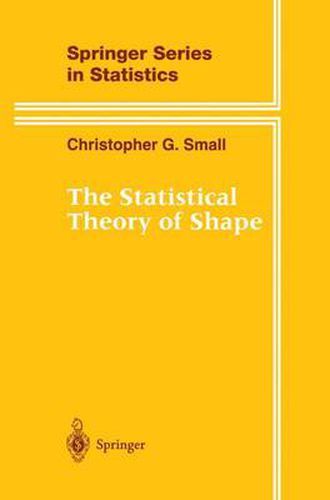Readings Newsletter
Become a Readings Member to make your shopping experience even easier.
Sign in or sign up for free!
You’re not far away from qualifying for FREE standard shipping within Australia
You’ve qualified for FREE standard shipping within Australia
The cart is loading…






This title is printed to order. This book may have been self-published. If so, we cannot guarantee the quality of the content. In the main most books will have gone through the editing process however some may not. We therefore suggest that you be aware of this before ordering this book. If in doubt check either the author or publisher’s details as we are unable to accept any returns unless they are faulty. Please contact us if you have any questions.
In general terms, the shape of an object, data set, or image can be de fined as the total of all information that is invariant under translations, rotations, and isotropic rescalings. Thus two objects can be said to have the same shape if they are similar in the sense of Euclidean geometry. For example, all equilateral triangles have the same shape, and so do all cubes. In applications, bodies rarely have exactly the same shape within measure ment error. In such cases the variation in shape can often be the subject of statistical analysis. The last decade has seen a considerable growth in interest in the statis tical theory of shape. This has been the result of a synthesis of a number of different areas and a recognition that there is considerable common ground among these areas in their study of shape variation. Despite this synthesis of disciplines, there are several different schools of statistical shape analysis. One of these, the Kendall school of shape analysis, uses a variety of mathe matical tools from differential geometry and probability, and is the subject of this book. The book does not assume a particularly strong background by the reader in these subjects, and so a brief introduction is provided to each of these topics. Anyone who is unfamiliar with this material is advised to consult a more complete reference. As the literature on these subjects is vast, the introductory sections can be used as a brief guide to the literature.
$9.00 standard shipping within Australia
FREE standard shipping within Australia for orders over $100.00
Express & International shipping calculated at checkout
This title is printed to order. This book may have been self-published. If so, we cannot guarantee the quality of the content. In the main most books will have gone through the editing process however some may not. We therefore suggest that you be aware of this before ordering this book. If in doubt check either the author or publisher’s details as we are unable to accept any returns unless they are faulty. Please contact us if you have any questions.
In general terms, the shape of an object, data set, or image can be de fined as the total of all information that is invariant under translations, rotations, and isotropic rescalings. Thus two objects can be said to have the same shape if they are similar in the sense of Euclidean geometry. For example, all equilateral triangles have the same shape, and so do all cubes. In applications, bodies rarely have exactly the same shape within measure ment error. In such cases the variation in shape can often be the subject of statistical analysis. The last decade has seen a considerable growth in interest in the statis tical theory of shape. This has been the result of a synthesis of a number of different areas and a recognition that there is considerable common ground among these areas in their study of shape variation. Despite this synthesis of disciplines, there are several different schools of statistical shape analysis. One of these, the Kendall school of shape analysis, uses a variety of mathe matical tools from differential geometry and probability, and is the subject of this book. The book does not assume a particularly strong background by the reader in these subjects, and so a brief introduction is provided to each of these topics. Anyone who is unfamiliar with this material is advised to consult a more complete reference. As the literature on these subjects is vast, the introductory sections can be used as a brief guide to the literature.